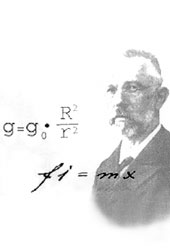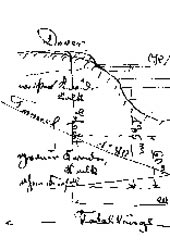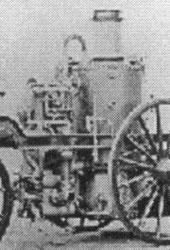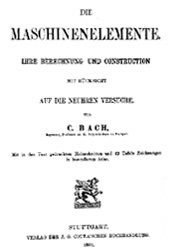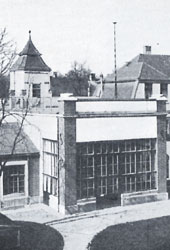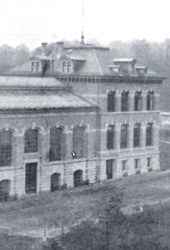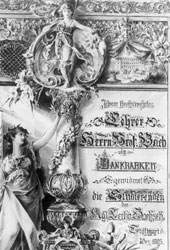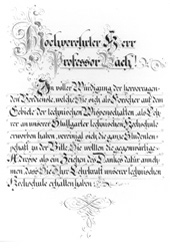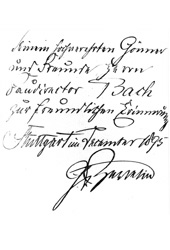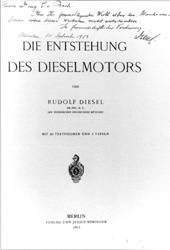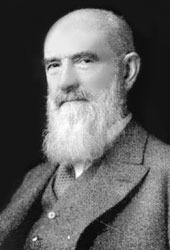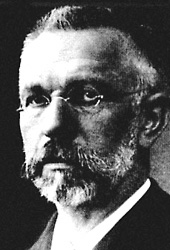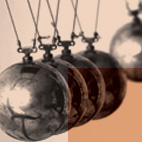 |
|
||||||||||||||||||||||||||||||||
|
|||||||||||||||||||||||||||||||||
|
Carl Julius von Bach and the rise of the engineering sciences By Werner Müller It sounds like the story of dishwasher turned millionaire, only here it is the story of the son of a saddler who managed to become a titled university professor - the story of Carl Julius von Bach (1847-1931). It was he who, over a hundred years ago, had the idea of building a tunnel link between Britain and France. And had it not been for him, the diesel engine might never have been invented.
How to have a successful career"Where there's a will, there's a way" – this saying is a good description of the time Bach spent as a trainee. His pre-university career contains many elements that would be typical of a promising career, such as gaining foreign language skills and travelling abroad.
The early bird catches the worm ...Bach's day began at 4 in the morning. He managed with only three or four hours' sleep. He kept this habit, which he had begun as a school pupil, for the rest of his life. He used the extra time to expand his horizons, such as taking evening classes and learning French during his time as an apprentice. He devised an personal sport schedule to improve his health, which was poor in his childhood and youth, and strictly kept to it. “During my apprenticeship I used my Sundays, if they weren't taken up the the Trade Association's Sunday school, to go on 3-4-hour walks in the hills, weather permitting, which I set off on at 4 in the morning, or to practise drawing, or to improve my mind.”
A long-term student ...Bach needed eight years to finish his diploma (1864-1872), with many interruptions, as he was constantly short of money. A present of money from his grandmother allowed him to start studying in Chemnitz. After a break of almost two years a craftsman lent him money so that he could take up his studies again in Dresden. He then followed his teacher Kankelwitz to the Polytechnic in Stuttgart, again to earn money assisting him in practical construction courses for younger students. After serving in the Franco-German War of 1870/71 he finally received his diploma at the Polytechnic in Karlsruhe in 1872.
A cure for seasickness ...Bach worked for a year in London and used the time to attend Kings College alongside his work. Bach had the idea of constructing a tunnel between England and France when he became seasick crossing the Channel to England. He saw no problems in the technical aspects of putting his plan into practice, as he had seen mines in England whose galleries stretched far beneath the sea without flooding. There was also already a tunnel under the Thames, and the St. Gotthard Tunnel was being built at the time. Bach even carried out a business calculation, and arrived at an interest rate of 7.2% for the prospective invested capital. One important aspect was the reduction of transport costs for goods traffic between England and the Continent.
First work experience ...After working as a senior engineer in Vienna, Bach became the manager of a factory in Bautzen. The company produced steam-powered fire engines, steam engines, pumps and water wheels. His duties included overseeing production, and carrying out construction work and quality controls. A by-product of this work was a patent for a "steam-powered fire engine with an extinguisher", which he invented together with a chief fire officer from Berlin.
Professor in StuttgartIn 1878 Bach was appointed professor at Stuttgart Polytechnic and for almost half a century placed his mark on the engineering sciences. Bach brought a wide range of experience in theory (his training) and practice (his work) to his activity as a professor. He applied these to teaching, research and cooperation with industry.
Trial and error ...In the 19th century it was industrial practice alone that was responsible for technological progress – with all the negative consequences that entailed. Systematic experiments were unknown. The only method used was trial and error. If, for example, a steam boiler had proven to be reliable in practice, its technical specifications were copied for other boilers. If it wasn't reliable, BOOM! The disadvantages of this method manifested themselves in numerous steam boiler explosions killing many people. All that could be done was to reinforce the boiler casing for the next model. The same approach was also used for other machines and in the construction of iron bridges. Thus increasingly urgent calls were made for reliable assessments of the properties of materials, for dependable detection of flaws in components and well-founded estimates of the life span of parts.
Training philosophy I – don't be averse to getting your hands dirty ...For Bach the purpose of studying was to "train independent, free-thinking engineers on the basis of what facts and life teach us". He introduced compulsory one-year work experience in the workshop as a prerequisite for studying, both to ensure that prospective students gathered practical experience, and in the conviction that "engineers must be a role model for workers in all respects" and should not look down on manual workers.
Training philosophy II – expand your horizons ...Bach was convinced that the college shouldn't just be a technical school that trained students in one discipline only. It should also contribute to "preparing for citizenship". He was also committed to putting these convictions into practice. Thus lectures in Law, Public Administration and Economics were also offered to students of Mechanical Engineering. Lectures in Philosophy and History of Technology were also part of Mechanical Engineering courses.
Theory and practice have to go hand in hand ...Bach criticised the contrast between theory and practice in Mechanical Engineering. This was visible in the fact that teaching was divided into "Practical Mechanical Engineering" and "Theoretical Mechanical Science". The teaching staff passed the subject matter they wouldn't or couldn't teach on to their "practical" colleagues, and vice versa. Bach made a major contribution to to overcoming this dispute by bringing theory and practice together. The position of mathematics in engineering training was a further point of dispute at the end of the 19th and beginning of the 20th century. The training provided by Mathematics professors wasn't sufficiently oriented towards engineers' future career needs. Bach took on the role of a mediator in this dispute too. He worked in various committees (composed of mathematicians and engineers) that dealt with training matters. In Stuttgart he introduced a supplementary introductory lecture on further mathematics for mechanical engineers, in addition to the existing lecture on further maths. "Where a contrast between science and practice appears, a close examination usually soon shows that either the fundamental assumptions the scientific observation was based on are incorrect, or that the conclusions drawn are flawed. From the very beginning, that is to say, from when I began teaching in the year 1878, I have made it my task to make my modest contribution to removing contrasts of this kind. Science and applied technology must go hand in hand by their very nature. Wherever this state does not exist, both parties have to work with ardour and perseverance to bring it about."
Textbooks can be bestsellers ...Textbooks are the basis for good university training. Bach did not restrict himself to lamenting the lack of textbooks. He improved the situation by writing them himself. The "classic" among these was his book "The elements of machinery – their calculation and construction", the first edition of which set new standards for decades to come when published in 1881. Its status as a bestseller can be seen in the fact that it ran to thirteen editions and was translated into several languages. Another milestone book was "Elasticity and Solidity", which appeared in 1889 and had run to a respectable 9 editions by 1924.
The tradition of third-party funding begins in Stuttgart ...Bach lacked the facilities in Stuttgart to put his training philosophy into practice and to conduct practical experiments on solidity. "The lack of facilities for testing and investigating the properties of construction materials had been painfully felt by the members of our college as early as the seventies. Repeated negotiations on this matter had been held without leading to a satisfactory fulfilment of extant requirements via the normal channels, i.e. by establishing a materials testing institute with state funding. This was all the more regrettable as the neighbouring Munich College of Technology had had a testing institute equipped with extensive facilities since 1871, and the Federal Polytechnic in Zurich had been given an institute of this kind in the year 1879." Bach needed many years until, in 1907, he could move into his – in his own words - "newly built and excellently equipped materials testing institute" in Stuttgart-Berg. It had been founded back in 1884 in existing buildings. In the middle of the recession this development had only been made possible by Bach's leaving the traditional funding route. He actively organised a publicity campaign for his discipline and his ideas. Bach persuaded the Württemberg Engineers' Association (WIV) to lobby for the surplus remaining from the State Trade Exhibition to be used to found the Materials Testing Institute. A sum of 10,000 marks was granted, supplemented by a subsidy of 6,000 marks from the state coffers. Background information: WIV The Württemberg Engineers' Association or Württemberg Regional Association of the Association of German Engineers (VDI) was founded in 1877, 21 years after the foundation of the Germany-wide association. The purpose of the association was and is to support commerce and industry. The association had a strong influence on technological growth in the region. Its major achievements included its successful efforts to establish the Materials Testing Institute and a chair of Electrical Engineering. The practical training of mechanical engineers was a further ongoing issue. Bach was a member of the WIV and chairman from 1882 to 1883.
Bit by bit an engineering laboratory begins to form ...At the end of the 19th century the engineering laboratory became the central facility for the engineering sciences. It served the dual purpose of research and providing practical training for students (in the form of experiments). Bach took an unconventional approach to circumventing funding shortages for this project as well. The key acquisition for the engineering laboratory, which was intended to focus specifically on studying engines and steam-powered machinery, including steam boilers, was a steam engine. Bach needed 5 years (1880-1885) to complete this acquisition, as the shortage of funding forced him to buy the engine bit by bit. "I wish only to remind everyone that in 1880, in order to obtain a steam engine on which the students might at least practise indexing, I began to purchase a steam cylinder, the cost of which was 1440 marks, which was paid in the financial years 1880 and 1881/82. By the financial year 1885/86 it had been possible, whilst keeping to the available funding for teaching aids, to acquire the remaining parts of a steam engine, i.e. to return the steam cylinder and obtain an entire steam engine, so that the acquisition of teaching premises could then be tackled." The establishment of laboratories was the crux of the dispute between the proponents of theory and practical experience. Supporters of laboratories were given support by the Association of German Engineers and by an expert commission consisting of representatives of the colleges of technology, business and politics. They drew up a policy document calling for the provision of sufficient funds for the establishment and planning of engineering laboratories at colleges. The WIV also petitioned the Ministry of Church and Social Affairs, likewise demanding an expansion of the laboratory. In 1897 the funding for the new building was finally granted – the appointments that Bach had been offered by other colleges and universities precipitated this decision (see Popular man). The newly constructed engineering laboratory was opened in 1900. The VDI's decisions of 1895 and the lobbying by industry in their favour led to success not only in Stuttgart but elsewhere too. In the years that followed, engineering laboratories were established in other cities, including Berlin (1899), Dresden (1902), Braunschweig (1903), and Gdańsk (then Danzig) and Darmstadt (1904). Background information: WIV The Württemberg Engineers' Association or Württemberg Regional Association of the Association of German Engineers (VDI) was founded in 1877, 21 years after the foundation of the Germany-wide association. The purpose of the association was and is to support commerce and industry. The association had a strong influence on technological growth in the region. Its major achievements included its successful efforts to establish the Materials Testing Institute and a chair of Electrical Engineering. The practical training of mechanical engineers was a further ongoing issue. Bach was a member of the WIV and chairman from 1882 to 1883.
A popular man ...The respect a scientist enjoys can be measured in many ways, including the number of appointments they are offered by other colleges and universities. Bach was a highly coveted academic. Within 8 years he received offers from several renowned institutions: the Federal Polytechnic in Zurich, Berlin College of Technology and Vienna College of Technology. Luckily for Stuttgart, he declined all these offers. But he used them as a means of pressurising the college, city and state into providing more financial support for his ideas and projects. The funding for the new engineering laboratory, for example, became more readily available when it became clear that he had been offered a position in Zurich. Bach's popularity can also be seen in a letter of thanks from his students, written when Bach rejected the appointment in Zurich.
Side effectsBach's activities not only had an effect on the college, but also influenced numerous other contemporary projects.
AirshipsBach was in contact with Count Zeppelin and supported him in his plans to build a manoeuvrable airship. After initial scepticism ("Leave it be! You'll lose your money and your mind.") he eventually allowed himself to be persuaded ("You'll make it!"). Bach gave Zeppelin advice on materials and technology, wrote a positive expert opinion on the venture, and recommended him qualified graduates for his project. Bach became one of Zeppelin's most important advocates in the German Engineers' Association (VDI).
The diesel engineRobert Diesel told Bach that his book "Elements of machinery" had given him important insights for the design of his engine. When, in my helplessness, I looked through the literature of the time, I came across the recently published 2nd edition of C. Bach's "Elements of machinery", which enthralled me so much that I immediately forgot about my engine and devoured Bach's book from the first to the last page, an undertaking that took me – in view of my otherwise strenuous activities – almost a year. Yet this time was not wasted, for then – at least, so I believe – I was able to construct my engine; the book had taught me to literally feel what happens in every organ of a machine, just as a gymnast doing an exercise feels how his limbs are stretched, pressed and bent; the machine had become a living being inside me, one I understood completely and with which I felt at one."
Württemberg Steam Boiler Inspection AssociationThe Württemberg Steam Boiler Inspection Association was founded on 5 April 1885. Bach was the first chairman and retained the post until 1927. Steam boiler inspection associations were founded in the industrial centres throughout the German states. They were mainly established by operators of steam boiler systems as a consequence of the high number of devastating accidents, leading to many casualties and the destruction of production plants. State controls did not bring about any improvement, as they were conducted by civil servants who had no suitable training or experience. The associations had inspectors who regularly checked the boiler systems. In Württemberg there were close links between the Steam Boiler Inspection Association and the WIV, both at a staff level through Bach and through the joint development of standards, such as for inspecting boilers and training for stokers. The steam boiler inspection associations were renamed as "Technical Inspection Associations" (TÜV) by an act of the German Economics Ministry in 1938. Background information: WIV The Württemberg Engineers' Association or Württemberg Regional Association of the Association of German Engineers (VDI) was founded in 1877, 21 years after the foundation of the Germany-wide association. The purpose of the association was and is to support commerce and industry. The association had a strong influence on technological growth in the region. Its major achievements included its successful efforts to establish the Materials Testing Institute and a chair of Electrical Engineering. The practical training of mechanical engineers was a further ongoing issue. Bach was a member of the WIV and chairman from 1882 to 1883.
The Robert Bosch FoundationRobert Bosch was a friend of Bach's. The friendship led to the establishment of a Robert Bosch Foundation in 1910, endowed with 1,000,000 marks, which particularly benefited the technical disciplines (the Engineering Laboratory received 350,000 marks and the Materials Testing Institute 100,000 marks). It was Robert Bosch's first major capital foundation.
One of his pupilsBach had many famous pupils. One example is Franz Lappe, whose work on high-pressure chemical engineering was a major contribution towards being able to conduct ammonia synthesis based on the Haber-Bosch process. Bach would have liked to keep him as senior engineer in his engineering laboratory, but Lappe wanted to engage in practical work. After being given a special recommendation by Bach, he started work in the Baden Aniline and Soda Factory (BASF) in 1907. He became a close colleague of Carl Bosch (Robert Bosch's nephew), whose task it was to transfer the synthesis of ammonia from the laboratory to large scale plants. Carl Bosch was awarded the Nobel Prize in 1931 for completing this achievement. Carl Bosch explicitly highlighted Franz Lappe's achievements at the end of his Nobel lecture: "It scarcely need be added that this achievement has only been made possible by a large staff of colleagues. It is probably true to assert that such numbers have never before been engaged on one single problem. I sincerely wish to mention in particular two colleagues present here to-day who threw themselves heart and soul into our work from the very outset, namely Dr. Mittasch, head of the scientific laboratory, and Dr. Lappe who was in charge of technical development. To them I would like to acknowledge now my gratitude for their unstinting, loyal co-operation." (Carl Bosch: The development of the chemical high pressure method during the establishment of the new ammonia industry. Nobel Lecture, May 21, 1932.)
The legacyA total of eight institutes of today's Universität Stuttgart have their roots in the Materials Testing Institute and the Engineering Laboratory:
The university archives of the Technical University of Chemnitz contain Carl Bach's extensive and wide-ranging legacy. It contains about 20 metres of archived material and is composed of biographical material, scientific papers, the manuscripts of various editions of his major works, and Bach's business and private correspondence.
Biography: Carl von Bach (1847 - 1931)
|
|
Last updated 04/10/2006 ( |
